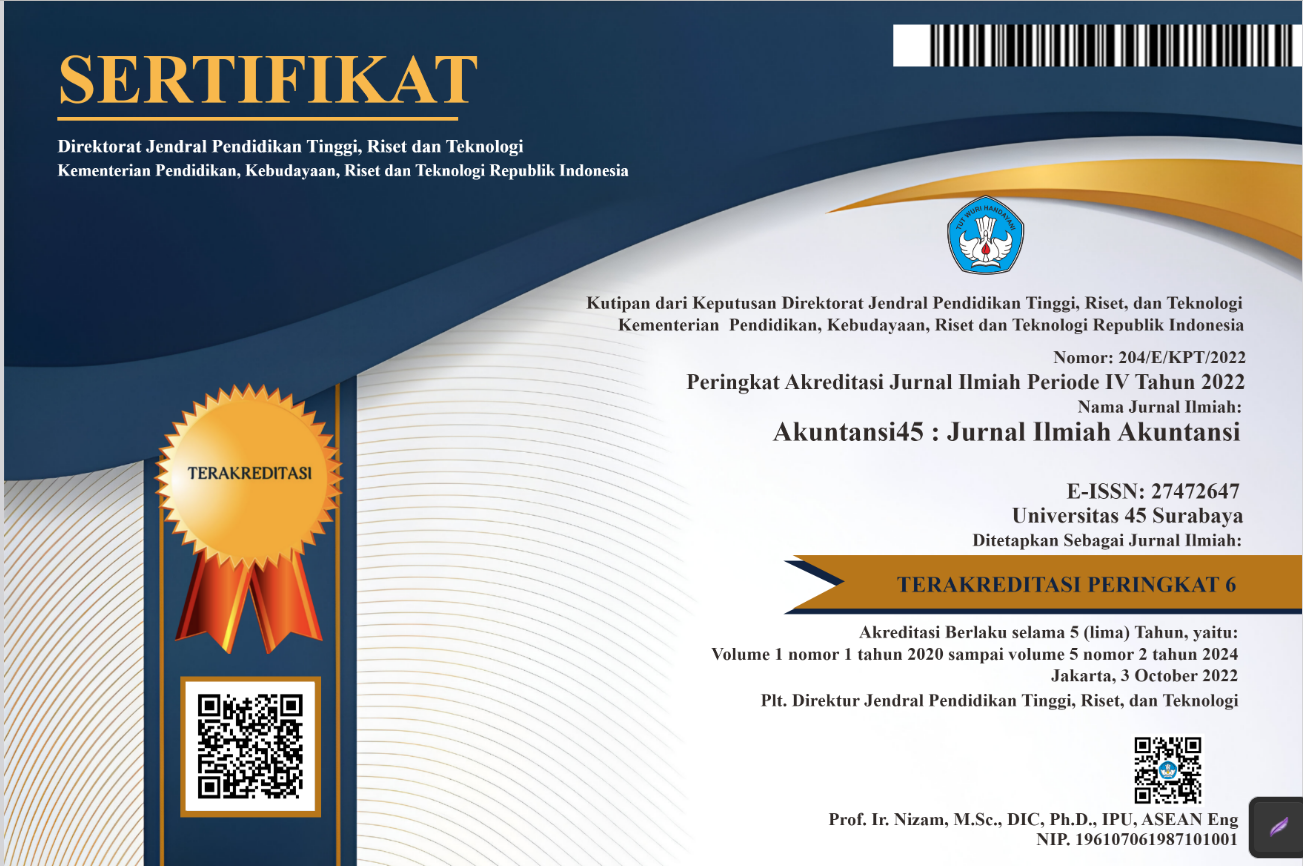Pengaruh Book Tax Differences, Kepemilikan Manajerial, Dan Leverage Terhadap Persistensi Laba
Studi Perusahaan Property Dan Real Estate di Bei Tahun 2020 – 2023
DOI:
https://doi.org/10.30640/akuntansi45.v6i1.4224Keywords:
Earnings Persistence, Book tax difference, Managerial Ownership, Leverage, Indonesia Stock ExchangeAbstract
This study aims to examine the influence of Book tax differences, managerial ownership, and leverage on earnings persistence in companies. Using a quantitative approach with multiple linear regression analysis, this research processes financial statement data to test the relationships between these variables. The findings reveal that Book tax differences and managerial ownership have a negative impact on earnings persistence. This indicates that the greater the disparity between financial accounting and taxation, as well as the higher the proportion of shares owned by managers, the lower the company's earnings sustainability. Meanwhile, leverage does not have a significant effect on earnings persistence, suggesting that a company's debt level does not determine long-term earnings stability. These findings align with agency theory, which highlights conflicts of interest between managers and shareholders, as well as signaling theory, which emphasizes the importance of financial information in assessing a company's performance.
References
Ardianti, R. (2018). Pengaruh alokasi pajak antar rentang, persistensi laba, profitabilitas, dan likuiditas atas kualitas laba (studi empiris pada korporasi manufaktur yang termaktub di BEI tahun 2012–2016). Jurnal Akuntansi, 6(1), 88–105.
Arumsari, V. F., & Handayani, N. (2017). Pengaruh kepunyaan saham, profitabilitas, leverage, dan opini auditor atas audit delay. Jurnal Ilmu dan Riset Akuntansi, 6(4).
Dewi, A., & Putri. (2015). Pengaruh book tax difference, arus kas akrual, dan ukuran korporasi pada persistensi laba. E-Jurnal Akuntansi Universitas Udayana.
Fadliansyah, M. E. (2020, August 12). Laba korporasi properti anjlok hingga 60%, bagaimana di semester II? Katadata. https://katadata.co.id/happyfajrian/finansial/5f342f918d36a/laba-korporasi-properti-anjlok-hingga-60-bagaimana-di-semester-ii
Fahmi, I. (2015). Analisis financial statement. Bandung: Alfabeta.
Fatani, Z. (2010). Analisis elemen-elemen penentu persistensi laba. Jurnal Akuntansi dan Keuangan Indonesia, 7(1).
Harahap, S. S. (2015). Teori akuntansi. Jakarta: Rajawali Pers.
Jensen, M. C., & Meckling, W. H. (1976). Theory of the firm: Managerial behavior, agency cost and ownership structure. Journal of Financial Economics, 3, 305–360. http://www.nhh.no/for/courses/spring/eco420/jensenmeckling-76.pdf
Kartika, O. (2020). Pengaruh kepemilikan manajerial dan kepunyaan institusional atas performa keuangan pada korporasi manufaktur sektor barang konsumsi yang termaktub di Bursa Efek Indonesia tahun 2016–2018.
Kasmir. (2017). Analisis financial statement. Jakarta: PT Rajagrafindo Persada.
Kurniawati, B. R., & Triyono. (2020). Pengaruh karakteristik keuangan atas kualitas laba (studi empiris pada korporasi manufaktur yang termaktub di Bursa Efek Indonesia tahun 2016–2018). Universitas Muhammadiyah Surakarta.
Kusuma, B., & Arja, R. (2014). Analisa pengaruh volatilitas arus kas, volatilitas penjualan, tingkat hutang, book tax gap, dan tata kelola korporasi atas persistensi laba.
Lipe, R. (1990). The relation between stock returns and accounting given earnings alternative information. The Accounting Review, 65(1), 49–71.
Mahulae, E. E., Pratomo, D., & Nurbaiti, A. (2016). Pengaruh kepunyaan institusional, kepemilikan manajerial dan komite audit atas tax avoidance. E-Proceeding of Management, 3(2).
Marhamah, Susanto, E., & Sari, V. N. (2020). Analisis determinan persistensi laba. Jurnal STIE Semarang, 12(3), 57–71.
Marlina, I. (2021). Pengaruh persistensi laba, ukuran korporasi dan likuiditas atas kualitas laba.
Maryam, S. (2014). Analisis pengaruh firm size, growth, leverage, dan profitabilitas atas nilai korporasi (studi pada korporasi manufaktur yang termaktub di Bursa Efek Indonesia). Universitas Hasanuddin.
Nuraini, M. (2014). Analisis elemen–elemen penentu persistensi laba [Skripsi, Universitas Diponegoro].
Penman, S. H., & Zhang, X. J. (2002). Accounting conservatism, the quality of earnings, and stock return. The Accounting Review.
Rachmawati, A. (2014). Pengaruh large positive abnormal book tax differences atas persistensi laba. Jurnal Akuntansi dan Keuangan Indonesia, 11(2).
Sihotang, B., Agustina, D., & Sumiyati. (2023). Pengaruh ukuran korporasi, kepemilikan manajerial, fee audit, tingkat hutang dan arus kas operasi atas persistensi laba pada korporasi properti dan real estat yang termaktub di Bursa Efek Indonesia rentang 2018–2022. Jurnal Bisnis Mahasiswa, 3(3), 126–140. https://doi.org/10.60036/jbm.v3i3.124
Spence, M. (1973). Job market signaling. The Quarterly Journal of Economics, 87(3), 355–374.
Weston, J. F., & Copeland, T. E. (1997). Manajemen keuangan (Vol. 2, Edisi ke-8). Jakarta: PT Glora Aksara Pratama.
Windarti, A., & Sina, I. (2017). Book tax difference dan struktur kepunyaan sebagai upaya penghindaran pajak. JABE (Journal of Applied Business and Economic), 4(1), 1. https://doi.org/10.30998/jabe.v4i1.1903
Downloads
Published
How to Cite
Issue
Section
License
Copyright (c) 2025 AKUNTANSI 45

This work is licensed under a Creative Commons Attribution-ShareAlike 4.0 International License.









